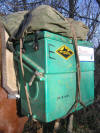






Another view. Note that here you can see how the last horse is tied onto the leading pack horse with a quick release bowline around the back steel bar of the pack saddle.
Secrets of Central Asian Pack Saddles
Australian equestrian traveller Tim Cope is currently en route on an 8,000 mile solo ride from Mongolia to Hungary, an historic journey which will take him over the hoof prints of the Central Asian nomads who rode into Europe more than 800 years ago. During the course of his journey, Tim has already documented how the horsemen of Kazakhstan are still using the terlik, a horse hair saddle pad used by their nomadic ancestors.
(http://www.thelongridersguild.com/genghis-saddlepad.htm )
With his arrival in Hungary only a few months away, Tim has now contacted The Guild to share some of the Central Asian skills he has learned on his fantastic journey.
Dear Long Riders,
Here are some pictures and information I have been promising to share with regards to my system for tying up and leading pack horses.
Some things as I have mentioned work very well:
20m of 8-10mm climbing rope (static or dynamic doesnít really matter) is perfect for both tethering length at night, and for tying down loads.
Now, I was certainly not impressed by all of those very complicated packing knots I read about on some traditional horse packing websites. But the Mongolians taught me a system which is simple, and works extremely well.
This tying takes about three to five minutes and supports the boxes or bags so that there is no movement either side to side or up and down. Additionally, it works far more favorably than a general belt/tie around the load and horse.
Whatís more, the ropes support the boxes and relieve pressure off the ropes from which the boxes hang. This means that in the event that a box rope or bag rope snaps (it has happened to me) this system ensures that the box does not fall to the ground and scare your animals.
Anyway, here are some pictures to explain how it is done.
Now, in terms of leading horses, if you ride along holding the pack horseís lead rope in your hand, you are bound to encounter any one of a number of dangerous and painful problems, including a strained shoulder or having your hands burned by the lead rope being pulled out of your hands when your pack horse shies. To make matters worse, these problems usually occur when you are in a dangerous situation which requires you to have complete control over both your riding and pack horse. You canít do that if you only have one hand on the controlling reins of your riding horse.
So I have adapted a Mongolian/Kazakh system of leading horses. By using their Central Asian methods I came up with a very simple solution which has worked very well.
I put a collar around the horse with or without a circular metal ring. I thread the lead rope through this collar and bring it back to me. When I am trotting I hold the rope, but most of the time I sit on the rope. If a horse pulls back or is dragging the chain a bit, your sitting weight is enough not to lose the horse. If the horse pulls really hard, all he does is slow down my mount. Horses are extremely strong in the chest and neck and to date despite many scares, I have never had a horse injured doing it this way.
In an emergency when you have to let the pack horses cut loose, all you have to do is sit up slightly in the saddle and presto. If they pull extremely hard or come to a complete halt then this will be enough to pull it our from under you anyway and nothing will break (not the horse, the saddle, a clip, halter, or your arm!).
The only problem is that sometimes this rope rubs on the knee pads of my stock saddle. I have therefore screwed in a piece of rubber which wears away slowly and protects the saddle.
In terms of tying the second pack horse to the first, I have always tied it to the back of the pack saddle with a quick release bow line so it is easy to undo even if pulled extremely tight. I have only had one situation when a saddle was pulled off the horse due to a scare and it was very manageable. I have also tried tying on to the tail of the horse, on to the neck etc, but none of these are long term solutions when you are riding for hours on end over varied terrain.
Home Top Back to News page Back to Pack Saddle page